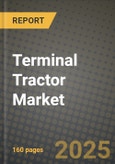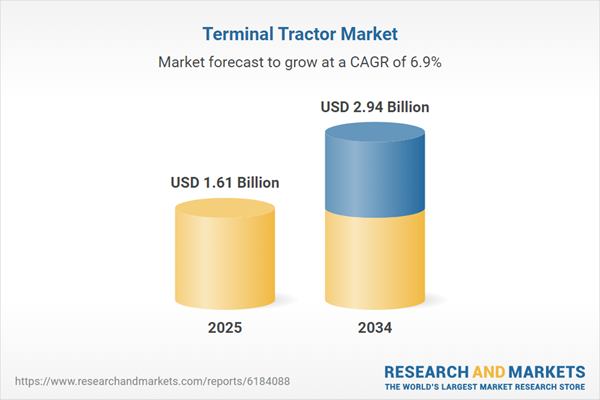Terminal Tractor Market
Terminal tractors - also known as yard trucks, yard spotters, and shunt tractors - are purpose-built for fast trailer maneuvering in ports, intermodal rail yards, and distribution centers. Their short wheelbase, high-visibility cabs, and hydraulic fifth-wheel lifts enable rapid coupling/decoupling, maximizing gate and dock throughput while reducing congestion and driver strain. Core applications include container handling at seaports and inland depots, cross-dock and e-commerce fulfillment, beverage and grocery distribution, and automotive logistics. The product set spans off-road and on-road (DOT-compliant) variants, 4×2 and 6×4 configurations, and powertrains ranging from clean-diesel and CNG/LNG to battery-electric and emerging hydrogen fuel-cell options. Current trends are defined by fleet decarbonization mandates at ports and large retailers, rapid maturation of electric yard tractors with depot charging, and software-led productivity via telematics, geo-fencing, smart idle, and preventive maintenance analytics. Ergonomics and safety features - 360° cameras, proximity sensors, auto-park, and slip-resistant access - are increasingly decisive in procurement. The competitive landscape combines global OEMs, regional specialists, and electrification pioneers, supported by dealer networks offering 24/7 mobile service, parts availability, rental/leasing, and “truck-as-a-service” packages that bundle vehicle, charging, uptime guarantees, and battery end-of-life solutions. Aftermarket and rebuild programs extend asset life, while connectivity platforms integrate with terminal operating systems (TOS), warehouse management systems (WMS), and yard management systems (YMS) to orchestrate moves based on berth schedules and dock waves. Forward momentum rests on total cost of ownership (TCO) improvements from electrification, regulatory tailwinds, automation pilots for supervised autonomy, and resilient supply chains for chassis, axles, batteries, and power electronics.Terminal Tractor Market Key Insights
- Electrification becomes baseline option
- Hydrogen pilots for heavy duty and cold climates
- Clean-diesel remains workhorse in mixed fleets
- Software-orchestrated yards
- Safety and ergonomics as procurement levers
- On-road vs. off-road flexibility
- Financing innovation
- Parts, service, and rebuild economics
- Automation and remote operations
- Supply-chain resilience
Terminal Tractor Market Reginal Analysis
North America
Demand is anchored in big-box distribution, grocery, beverage, and intermodal rail, with ports pursuing zero-emission roadmaps. State and utility incentives support electric deployments and charging build-outs at DCs. Fleets value DOT-compliant tractors for campus shuttles and cross-dock moves. Dealer service density, rental pools, and mobile technicians are critical. Data integrations with WMS/YMS drive measurable dock and yard productivity gains.Europe
Decarbonization targets, low-emission zones, and ESG procurement accelerate electric adoption in ports and inland terminals. Intermodal rail growth and cross-border logistics favor on-road compliant specs. Safety, cab ergonomics, and visibility technologies face stringent expectations. Depot power planning emphasizes peak shaving and smart charging. Lifecycle strategies combine factory rebuilds with high parts standardization across fleets.Asia-Pacific
Large container ports, manufacturing hubs, and fast-growing e-commerce networks underpin volumes. China and developed Northeast Asia lead in electrified yard tractors and localized battery supply. Southeast Asian logistics parks expand off-road fleets with cost-optimized specs. Buyers prioritize uptime, local assembly/service partners, and telematics that integrate with regional TOS. Government industrial policies and port expansions support steady replacement cycles.Middle East & Africa
Mega-port investments and free-zone logistics parks drive greenfield opportunities. Harsh-climate specs - cooling, filtration, and robust air-conditioning - are prioritized. Electrification interest rises alongside solar-backed depot power, though diesel remains prevalent where infrastructure is nascent. Distributors with deep parts inventories and technician training win. Long warranties and rebuild pathways mitigate lifecycle risk.South & Central America
Port modernization and agrilogistics corridors sustain demand, with mixed fleets across off-road yards and short on-road shuttles. Currency volatility and import lead times make rental and lease models attractive. Diesel dominates today, while pilots for electric units grow in major gateways. Service responsiveness and parts availability drive procurement decisions. Public-private logistics investments shape medium-term growth and replacement pacing.Terminal Tractor Market Segmentation
By Drive
- 4x2
- 4x4
- Others
By Propulsion
- Diesel
- Electric
- Others
By Application
- Port Terminal
- Distribution Centers
- Warehouse
- Others
By Tonnage
- Below 50 Ton
- 50 to 100 Ton
- Above 50 Ton
By Vehicle
- Manual
- Automated
Key Market players
Kalmar (Cargotec/Ottawa), Terberg Group, Capacity Trucks, TICO Tractors, MAFI Transport-Systeme, MOL CY, Konecranes, Hyster-Yale Group, SANY, Gaussin, Orange EV, Autocar Trucks, BYD, Taylor Machine Works, Linde Material HandlingTerminal Tractor Market Analytics
The report employs rigorous tools, including Porter’s Five Forces, value chain mapping, and scenario-based modelling, to assess supply-demand dynamics. Cross-sector influences from parent, derived, and substitute markets are evaluated to identify risks and opportunities. Trade and pricing analytics provide an up-to-date view of international flows, including leading exporters, importers, and regional price trends.Macroeconomic indicators, policy frameworks such as carbon pricing and energy security strategies, and evolving consumer behaviour are considered in forecasting scenarios. Recent deal flows, partnerships, and technology innovations are incorporated to assess their impact on future market performance.
Terminal Tractor Market Competitive Intelligence
The competitive landscape is mapped through proprietary frameworks, profiling leading companies with details on business models, product portfolios, financial performance, and strategic initiatives. Key developments such as mergers & acquisitions, technology collaborations, investment inflows, and regional expansions are analyzed for their competitive impact. The report also identifies emerging players and innovative startups contributing to market disruption.Regional insights highlight the most promising investment destinations, regulatory landscapes, and evolving partnerships across energy and industrial corridors.
Countries Covered
- North America - Terminal Tractor market data and outlook to 2034
- United States
- Canada
- Mexico
- Europe - Terminal Tractor market data and outlook to 2034
- Germany
- United Kingdom
- France
- Italy
- Spain
- BeNeLux
- Russia
- Sweden
- Asia-Pacific - Terminal Tractor market data and outlook to 2034
- China
- Japan
- India
- South Korea
- Australia
- Indonesia
- Malaysia
- Vietnam
- Middle East and Africa - Terminal Tractor market data and outlook to 2034
- Saudi Arabia
- South Africa
- Iran
- UAE
- Egypt
- South and Central America - Terminal Tractor market data and outlook to 2034
- Brazil
- Argentina
- Chile
- Peru
Research Methodology
This study combines primary inputs from industry experts across the Terminal Tractor value chain with secondary data from associations, government publications, trade databases, and company disclosures. Proprietary modeling techniques, including data triangulation, statistical correlation, and scenario planning, are applied to deliver reliable market sizing and forecasting.Key Questions Addressed
- What is the current and forecast market size of the Terminal Tractor industry at global, regional, and country levels?
- Which types, applications, and technologies present the highest growth potential?
- How are supply chains adapting to geopolitical and economic shocks?
- What role do policy frameworks, trade flows, and sustainability targets play in shaping demand?
- Who are the leading players, and how are their strategies evolving in the face of global uncertainty?
- Which regional “hotspots” and customer segments will outpace the market, and what go-to-market and partnership models best support entry and expansion?
- Where are the most investable opportunities - across technology roadmaps, sustainability-linked innovation, and M&A - and what is the best segment to invest over the next 3-5 years?
Your Key Takeaways from the Terminal Tractor Market Report
- Global Terminal Tractor market size and growth projections (CAGR), 2024-2034
- Impact of Russia-Ukraine, Israel-Palestine, and Hamas conflicts on Terminal Tractor trade, costs, and supply chains
- Terminal Tractor market size, share, and outlook across 5 regions and 27 countries, 2023-2034
- Terminal Tractor market size, CAGR, and market share of key products, applications, and end-user verticals, 2023-2034
- Short- and long-term Terminal Tractor market trends, drivers, restraints, and opportunities
- Porter’s Five Forces analysis, technological developments, and Terminal Tractor supply chain analysis
- Terminal Tractor trade analysis, Terminal Tractor market price analysis, and Terminal Tractor supply/demand dynamics
- Profiles of 5 leading companies - overview, key strategies, financials, and products
- Latest Terminal Tractor market news and developments
Additional Support
With the purchase of this report, you will receive:- An updated PDF report and an MS Excel data workbook containing all market tables and figures for easy analysis.
- 7-day post-sale analyst support for clarifications and in-scope supplementary data, ensuring the deliverable aligns precisely with your requirements.
- Complimentary report update to incorporate the latest available data and the impact of recent market developments.
This product will be delivered within 1-3 business days.
Table of Contents
Companies Mentioned
- Kalmar (Cargotec/Ottawa)
- Terberg Group
- Capacity Trucks
- TICO Tractors
- MAFI Transport-Systeme
- MOL CY
- Konecranes
- Hyster-Yale Group
- SANY
- Gaussin
- Orange EV
- Autocar Trucks
- BYD
- Taylor Machine Works
- Linde Material Handling
Table Information
| Report Attribute | Details |
|---|---|
| No. of Pages | 160 |
| Published | November 2025 |
| Forecast Period | 2025 - 2034 |
| Estimated Market Value ( USD | $ 1.61 Billion |
| Forecasted Market Value ( USD | $ 2.94 Billion |
| Compound Annual Growth Rate | 6.9% |
| Regions Covered | Global |
| No. of Companies Mentioned | 15 |









